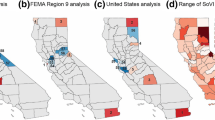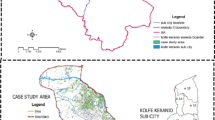Abstract
Rural public health still faces serious challenges in China. These challenges in rural public health reduce peasants’ well-being and social satisfaction. Examining the social factors of rural public health helps improve the public health in rural areas. This study attempts to characterize the relationship between social deprivation and rural public health in China. In particular, 14 indicators are integrated for assessing social deprivation, which is described from five domains: income, employment, education, housing and demographic structure. The analytic hierarchy process, Delphi method, entropy method and coefficient variation method are selected as weight determining methods to evaluate the corresponding weights for the indicators of social deprivation. Then, the best models are selected from ordinary least squares regression models, spatial lag models and spatial error models according to the performances of these models. The results of assessing social deprivation indicate that the spatial distribution of social deprivation has great heterogeneity in rural China. In addition, the relative levels of social deprivation among 31 provinces that are estimated by different weight determination methods remain stable. Finally, the spatial regression models reveal that social deprivation is a positive contributor to the maternal mortality rate and child mortality rate, while social deprivation presents negative relationships with the proportion of healthy elders.

Similar content being viewed by others
References
AbouZahr, C. (2003). Global burden of maternal death and disability. British Medical Bulletin,67(1), 1–11.
Ann, T. W., Wu, Y., Zheng, B., Zhang, X., & Shen, L. (2014). Identifying risk factors of urban-rural conflict in urbanization: A case of China. Habitat International,44, 177–185.
Anselin, L. (2005). Exploring spatial data with GeoDaTM: A workbook. Center for Spatially Integrated Social Science.
Anselin, L., & Bera, A. K. (1998). Spatial dependence in linear regression models with an introduction to spatial econometrics. Statistics Textbooks and Monographs,155, 237–290.
Black, R. E., Cousens, S., Johnson, H. L., Lawn, J. E., Rudan, I., Bassani, D. G., et al. (2010). Global, regional, and national causes of child mortality in 2008: A systematic analysis. The Lancet,375(9730), 1969–1987.
Braveman, P., & Gottlieb, L. (2014). The social determinants of health: It’s time to consider the causes of the causes. Public Health Reports,129(1_suppl2), 19–31.
Bukenya, J. O., Gebremedhin, T. G., & Schaeffer, P. V. (2003). Analysis of rural quality of life and health: A spatial approach. Economic Development Quarterly,17(3), 280–293.
Carstairs, V. D., & Morris, R. (1991). Deprivation and health in Scotland. Aberdeen: Aberdeen University Press.
Chen, L., Huang, J., & Li, J. (2017). Fiscal decentralization, satisfaction with social services, and inequality under the Hukou system. Social Indicators Research,132(1), 377–394.
Dai, B. (2015). The old age health security in rural China: Where to go? International Journal for Equity in Health,14(1), 119.
Dalkey, N., & Helmer, O. (1963). An experimental application of the Delphi method to the use of experts. Management Science,9(3), 458–467.
Elhorst, J. P. (2010). Applied spatial econometrics: Raising the bar. Spatial Economic Analysis,5(1), 9–28.
Feng, D., Chu, X., & Chen, W. (2016). Study of comprehensive evaluation of poverty reduction effect for Chinese poverty-stricken areas-based on the data of Chinese 14 contiguous poor areas. Applied Economics and Finance,3(3), 37–44.
Feng, X. L., Zhu, J., Zhang, L., et al. (2010). Socio-economic disparities in maternal mortality in China between 1996 and 2006. BJOG: An International Journal of Obstetrics & Gynaecology,117(12), 1527–1536.
Grewal, B., & Ahmed, A. D. (2011). Is China’s western region development strategy on track? An assessment. Journal of Contemporary China,20(69), 161–181.
Guildea, Z. E. S., Fone, D. L., Dunstan, F. D., Sibert, J. R., & Cartlidge, P. H. T. (2001). Social deprivation and the causes of stillbirth and infant mortality. Archives of Disease in Childhood,84(4), 307–310.
Guy, C. M., & David, G. (2004). Measuring physical access to ‘healthy foods’ in areas of social deprivation: A case study in Cardiff. International Journal of Consumer Studies,28(3), 222–234.
Haisken-DeNew, J., & Sinning, M. (2010). Social deprivation of immigrants in Germany. Review of Income and Wealth,56(4), 715–733.
Jordan, H., Roderick, P., & Martin, D. (2004). The index of multiple deprivation 2000 and accessibility effects on health. Journal of Epidemiology and Community Health,58(3), 250–257.
Kanbur, R., & Zhang, X. (2010). Fifty years of regional inequality in China: A journey through central planning, reform, and openness. Review of Development Economics,9(1), 87–106.
Krieger, J., & Higgins, D. L. (2002). Housing and health: Time again for public health action. American Journal of Public Health,92(5), 758–768.
Li, Y., & Dorsten, L. (2010). Regional and urban/rural differences of public health in China. Global Journal of Health Science,2(1), 20–30.
Li, Y., Long, H., & Liu, Y. (2015). Spatio-temporal pattern of China’s rural development: A rurality index perspective. Journal of Rural Studies,38, 12–26.
Liu, H., Fang, H., & Zhao, Z. (2013). Urban-rural disparities of child health and nutritional status in China from 1989 to 2006. Economics & Human Biology,11(3), 294–309.
Lucchini, M., Butti, C., Bella, S. D., & Lisi, A. (2018). The application of a topological clustering technique to capture forms and dynamics of deprivation in contemporary Switzerland. Quality & Quantity,52(3), 1–22.
Lv, Y., Wang, R. H., & Cai, Z. Y. (2009). Climate change and its influence on arid and semi-arid area of China. Journal of Arid Land Resources & Environment,23(11), 65–71.
Mabughi, N., & Selim, T. (2006). Poverty as social deprivation: A survey. Review of Social Economy,64(2), 181–204.
Maes, W. H., Fontaine, M., Ronge, M., Hermy, M., & Muys, B. (2011). A quantitative indicator framework for stand level evaluation and monitoring of environmentally sustainable forest management. Ecological Indicators,11, 468–479.
Marmot, M. (2005). Social determinants of health inequalities. The Lancet,365(9464), 1099–1104.
McLennan, D., Barnes, H., Noble, M., Davies, J., Garratt, E., & Dibben, C. (2011). The English indices of deprivation 2010. London: Department for Communities and Local Government.
Muir, K., Rattanamongkolgul, S., Smallman-Raynor, M., Thomas, M., Downer, S., & Jenkinson, C. (2004). Breast cancer incidence and its possible spatial association with pesticide application in two counties of England. Public Health,118(7), 513–520.
Noble, M., Barnes, H., Wright, G., & Roberts, B. (2010). Small area indices of multiple deprivation in South Africa. Social Indicators Research,95, 281–297.
Olusegun, O. L., Ibe, R. T., & Micheal, I. M. (2012). Curbing maternal and child mortality: The Nigerian experience. International Journal of Nursing and Midwifery,4(3), 33–39.
Pacheco, A. I., & Tyrrell, T. J. (2002). Testing spatial patterns and growth spillover effects in clusters of cities. Journal of Geographical Systems,4(3), 275–285.
Pan, G., Xu, Y., Yu, Z., Song, S., & Zhang, Y. (2015). Analysis of river health variation under the background of urbanization based on entropy weight and matter-element model: A case study in Huzhou City in the Yangtze River Delta, China. Environmental Research,139, 31–35.
Park, C. S., & Han, I. (2002). A case-based reasoning with the feature weights derived by analytic hierarchy process for bankruptcy prediction. Expert Systems with Applications,23(3), 255–264.
Pearce, J., Witten, K., Hiscock, R., & Blakely, T. (2007). Are socially disadvantaged neighborhoods deprived of health-related community resources? International Journal of Epidemiology,36, 348–355.
Rudan, I., Chan, K. Y., Zhang, J. S., et al. (2010). Causes of deaths in children younger than 5 years in China in 2008. The Lancet,375(9720), 1083–1089.
Singh, G. K., & Kogan, M. D. (2007). Widening socioeconomic disparities in US childhood mortality, 1969–2000. American Journal of Public Health,97(9), 1658–1665.
Smith, D. M., Cummins, S., Taylor, M., Dawson, J., Marshall, D., Sparks, L., et al. (2009). Neighbourhood food environment and area deprivation: Spatial accessibility to grocery stores selling fresh fruit and vegetables in urban and rural settings. International Journal of Epidemiology,39(1), 277–284.
Smith, H. J., Pettigrew, T. F., Pippin, G. M., & Bialosiewicz, S. (2012). Relative deprivation: A theoretical and meta-analytic review. Personality and Social Psychology Review,16(3), 203–232.
Strasser, R., Kam, S. M., & Regalado, S. M. (2016). Rural health care access and policy in developing countries. Annual Review of Public Health,37, 395–412.
Su, S., Yue, G., Tan, B., Pi, J., Min, W., & Cai, Z. (2017). Area social deprivation and public health: Analyzing the spatial non-stationary associations using geographically weighed regression. Social Indicators Research,133(3), 1–14.
Tan, Y., & Liu, X. (2017). Water shortage and inequality in arid Minqin Oasis of Northwest China: Adaptive policies and farmers’ perceptions. Local Environment,22(8), 934–951.
Thornicroft, G., Bisoffi, G., De Salvia, D., & Tansella, M. (1993). Urban-rural differences in the associations between social deprivation and psychiatric service utilization in schizophrenia and all diagnoses: A case-register study in Northern Italy. Psychological Medicine,23(2), 487–496.
Tian, M., Feng, D., Chen, X., et al. (2013). China’s rural public health system performance: A cross-sectional study. PLoS ONE,8(12), e83822.
Tipayamongkholgul, M., & Lisakulruk, S. (2011). Socio-geographical factors in vulnerability to dengue in Thai villages: A spatial regression analysis. Geospatial Health,5(2), 191–198.
Townsend, P. (1987). Deprivation. Journal of Social Policy,16(2), 125–146.
Viton, P. A. (2010). Notes on spatial econometric models. City and Regional Planning,870(03), 9–10.
Voss, P. R., Long, D. D., Hammer, R. B., & Friedman, S. (2006). County child poverty rates in the US: A spatial regression approach. Population Research and Policy Review,25(4), 369–391.
Walker, C. L. F., Rudan, I., Liu, L., Nair, H., Theodoratou, E., Bhutta, Z. A., et al. (2013). Global burden of childhood pneumonia and diarrhoea. The Lancet,381(9875), 1405–1416.
Wan, C., & Su, S. (2017). China’s social deprivation: Measurement, spatiotemporal pattern and urban applications. Habitat International,62, 22–42.
Wang, C., Rao, K., Wu, S., & Liu, Q. (2013). Health care in China: Improvement, challenges, and reform. Chest,143(2), 524–531.
Weng, M., Pi, J., Tan, B., Su, S., & Cai, Z. (2017). Area deprivation and liver cancer prevalence in Shenzhen, China: A spatial approach based on social indicators. Social Indicators Research,133(1), 317–332.
WHO. (2006). Commission on the social determinants of health. In Organisation GWH (Ed.), 5th meeting of the commission on the social determinants of health; 2006, 26–30 June; Nairobi Kenya (26–30 June).
Wilkinson, R. G., & Marmot, M. (Eds.). (2003). Social determinants of health: The solid facts. Geneva: World Health Organization.
World Health Organization, & UNICEF. (2013). Ending preventable child deaths from pneumonia and diarrhoea by 2025: The integrated Global Action Plan for Pneumonia and Diarrhoea (GAPPD).
Xie, T. (2011). Analysis on inter-provincial disparities of China’s rural education and convergence rate. International Journal of Educational Management,25(7), 714–723.
Xu, B., Fochsen, G., Xiu, Y., Thorson, A., Kemp, J. R., & Jiang, Q. W. (2004). Perceptions and experiences of health care seeking and access to TB care—A qualitative study in rural Jiangsu province, China. Health Policy,69(2), 139–149.
Yayla, M. (2003). Maternal mortality in developing countries. Journal of Perinatal Medicine,31(5), 386–391.
You, H. (2016). Characterizing the inequalities in urban public green space provision in Shenzhen, China. Habitat International, 56, 176–180.
You, H., Xiaowei, H., & Yizhou, W. (2018). Farmland use intensity changes in response to rural transition in Zhejiang province, China. Land Use Policy,79, 350–361.
You, H., & Zhang, X. (2017). Sustainable livelihoods and rural sustainability in China: Ecologically secure, economically efficient or socially equitable? Resources, Conservation and Recycling,120, 1–13.
Yuan, Y., & Wu, F. (2013). Regional social inequalities and social deprivation in Guangdong Province, China. Growth and Change,44(1), 149–167.
Acknowledgements
This research received financial support from the National Natural Science Foundation of China (71874151 and 71403235), the Humanity and Social Science Foundation of Ministry of Education of China (18YJA630134), the Zhejiang Provincial Natural Science Foundation of China (LY18G030031).
Author information
Authors and Affiliations
Corresponding author
Additional information
Publisher's Note
Springer Nature remains neutral with regard to jurisdictional claims in published maps and institutional affiliations.
Rights and permissions
About this article
Cite this article
You, H., Zhou, D., Wu, S. et al. Social Deprivation and Rural Public Health in China: Exploring the Relationship Using Spatial Regression. Soc Indic Res 147, 843–864 (2020). https://doi.org/10.1007/s11205-019-02183-z
Accepted:
Published:
Issue Date:
DOI: https://doi.org/10.1007/s11205-019-02183-z




